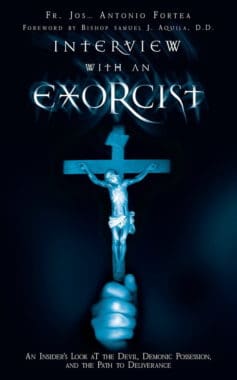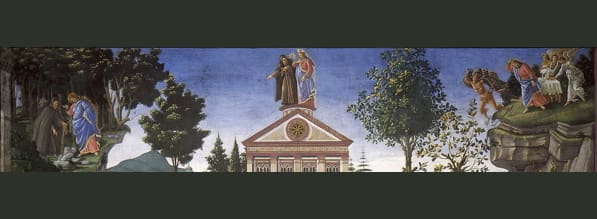Father Fortea, what order do the three temptations of Jesus in the desert follow? Is there any significance to this order?
 In the synoptic gospels, we see how the devil tempted Jesus in the wilderness immediately prior to the start of His public ministry (see Mt 4:1-11; Mk 1:9-15; Lk 4:1-13). These temptations were those of bread, power, and worldly recognition. Now then, why would the devil tempt Jesus to worship him when he did not even get Him to break His fast? In the end, why did he tempt Jesus with jumping off the pinnacle of the Temple? If Jesus had already rejected the glory of the whole world, why is the devil’s last temptation seemingly so minor?
In the synoptic gospels, we see how the devil tempted Jesus in the wilderness immediately prior to the start of His public ministry (see Mt 4:1-11; Mk 1:9-15; Lk 4:1-13). These temptations were those of bread, power, and worldly recognition. Now then, why would the devil tempt Jesus to worship him when he did not even get Him to break His fast? In the end, why did he tempt Jesus with jumping off the pinnacle of the Temple? If Jesus had already rejected the glory of the whole world, why is the devil’s last temptation seemingly so minor?
At first sight, it seems logical that the devil’s temptations of Jesus would have started with the greatest sin, and not achieving this, the devil would have moved on to lesser sins. So he would first tempt Jesus with idolatry and follow up with something that is not even a venial sin, such as breaking a voluntary fast.
 But one’s first impression is that the succession of the devil’s temptations does not follow a logical order. Actually, the succession of the devil’s attack follows a more subtle logic. It follows the order of temptations that a soul suffers when it decides to move forward with living a spiritual life. That is why there is a deep symbolism in these three temptations. The devil first tempts Jesus with things of the flesh, symbolized by the bread. This temptation symbolizes what the ascetic calls the “night of the senses.” If the soul resists this type of temptation (i.e., all the bodily appetites), there is no reason for the devil to continue tempting in this way because the soul has fortified itself against it. Having passed through the night of the senses, the devil then tempts with the world. The soul feels the beauty and attractions of the world that it has left. This is a symbol of the “night of the spirit.”
But one’s first impression is that the succession of the devil’s temptations does not follow a logical order. Actually, the succession of the devil’s attack follows a more subtle logic. It follows the order of temptations that a soul suffers when it decides to move forward with living a spiritual life. That is why there is a deep symbolism in these three temptations. The devil first tempts Jesus with things of the flesh, symbolized by the bread. This temptation symbolizes what the ascetic calls the “night of the senses.” If the soul resists this type of temptation (i.e., all the bodily appetites), there is no reason for the devil to continue tempting in this way because the soul has fortified itself against it. Having passed through the night of the senses, the devil then tempts with the world. The soul feels the beauty and attractions of the world that it has left. This is a symbol of the “night of the spirit.”
Here, the soul is tempted by the world in which it lives but no longer enjoys. If this temptation is resisted, one final danger remains: pride. This is pride in the gifts one has received from God.
These three temptations symbolize the phases of temptations we go through in the spiritual life. It has to be added that, concretely, those which the devil used with Jesus were especially subtle:
-First, the devil tempted Jesus not with sin but with imperfection. He was asked to stop doing a good, i.e., his fasting, and turn stones into bread.
-Then, He was tempted with the spiritual good of the world. It is as if the devil were saying, “Make a sign of acknowledgment toward me, proud as I am, and, as a reward, I will put myself at your side. All I ask is that you acknowledge me, and I will help you in your work of saving souls. Are you not humble? Are you not capable of lowering yourself a little more for the eternal good of souls?” This second temptation is packed with tremendous spiritual meaning. Jesus was not asked to stop being God; He was only asked to humble Himself a bit more. Could not the Just One, who had made so many sacrifices for souls, make one more? It is the temptation to do a little evil so as to achieve a great good.
-The final temptation is that of pride – to be publicly recognized. It was to prescind from the fact that it is God, in His time, who exalts His servants. Here, the devil was saying, “Even though God decides the time and the moment, why not bring the moment forward? Why remain in obscurity when so much good can be done by coming out into the light in a glorious and spectacular way?” We can see that this third temptation is the most complex and subtle of all.
 Editor’s Note: To learn more about spiritual warfare and demonology, Catholic Spiritual Direction recommends Fr. Fortea’s excellent book Interview With An Exorcist – An Insider’s Look at the Devil, Demonic Possession, and the Path to Deliverance.
Editor’s Note: To learn more about spiritual warfare and demonology, Catholic Spiritual Direction recommends Fr. Fortea’s excellent book Interview With An Exorcist – An Insider’s Look at the Devil, Demonic Possession, and the Path to Deliverance.
+
Art for this post on the three temptations of Jesus: Detail from Tentaciones de Cristo [Temptations of Christ], Sandro Botticelli, 1481-2, PD-US author’s life plus 100 years or less; detail of Padre José Antonio Fortea 2017, photographed by Elgatoconbotaselgatoconbotas, 5 May 2017 own work, CCA-SA 4.0 International; both Wikimedia Commons. Cover of “Interview with an Exorcist” used with permission, all rights reserved.




